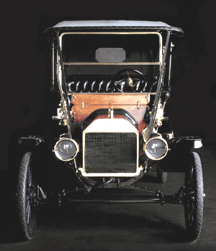Still Looking Great After 100 Years
When Henry Ford debuted his groundbreaking Model T on Sept. 27, 1908, he probably never imagined that the spindly little car would remain in production for 19 years. Nor could Ford have foreseen that his company would eventually build more than 15 million Tin Lizzies, making him a billionaire while putting the world on wheels.
 “Henry Ford and his Model T helped reshape the landscape of America a century ago by making the automobile accessible to the average person,” said Bill Ford, Ford Motor Company executive chairman during a recent celebration recognizing the 100-year anniversary of the car.
“Henry Ford and his Model T helped reshape the landscape of America a century ago by making the automobile accessible to the average person,” said Bill Ford, Ford Motor Company executive chairman during a recent celebration recognizing the 100-year anniversary of the car.
No one would argue Ford’s achievement to the auto industry and its effect on allowing Americans to move more freely. The Model T was the first low-priced, mass-produced automobile with standard, interchangeable parts. And, according to auto historians and automotive books, the Model T was transformed into tasks that reached beyond basic transportation.
As customers drove off dealers’ lots, thus began the quest of turning Tin Lizzies from cars into specialized vehicles to fit each owners’ needs.
New businesses that specialized in catering to the world’s most renowned car at the time began to pop up nearly overnight. These companies, advertising parts in various magazines, enabled Model T owners to transform their vehicle into a variety of machines. Mail-order catalogs from companies like Smith Form-A-Tractor, Sears & Roebuck and Montgomery Ward, offered conversion kits to alter the car into everything from farm tractors, mobile sawmills, racy roadsters and delivery trucks to yes, even snowmobiles.
So, the Model T — which Ford first advertised as “The Universal Car” — is attributed to launching today’s $200 billion automotive aftermarket industry – to which many of us owe our thanks. The Ford Difference
The first Model Ts sold for $825 (for a two-door roadster) — which back then was considered a bargain compared to other cars. But even more remarkable is that during its 19 years of production, Ford continued to steadily lower its price, thanks to manufacturing efficiencies including the moving assembly line introduced in 1913. Others believe prices were dropped to compete with vehicles being offered by General Motors at the time. Whatever the reason, the Model T’s affordability helped it account for more than 55% of the world’s automobile production by 1921.
So what made the “T” so different than other autos coming off the line back then?
According to the Antique Automobile Club of America (AACA) Museum — everything. The new car was simple yet sturdy. It was constructed of experimental vanadium steel which provided both lightness and durability and its four-cylinder, gas-powered engine was reliable and easy to service. Also available as a bare chassis it could be adapted for use as a truck or special-purpose vehicle adding to its inherent versatility.
And, if you could find a paved road, the Model T could reach speeds between 40-45 mph.
Historians have concluded that when the Model T’s engine was introduced, it was capable of running on gasoline or ethanol, a huge plus for farmers and others in rural areas who could make their own ethanol fuel. However, the decreasing cost of gasoline and the later introduction of Prohibition in the U.S. made ethanol an impractical fuel for the car down the road.
Paint it Black
You probably heard the old story that Ford’s Model Ts came in only one color — black. However, according to various auto books, no one really knows if Ford ever actually said that the public could have Model Ts “in any color, so long as it’s black.” While this statement is commonly attributed to him, Model Ts built before 1913 were available in Brewster Green, red, blue and gray. In fact, black wasn’t even an option in the first year of the car’s production.
However, by 1914, Ford Model T’s were coming off the lines painted all black, and color options weren’t available again until the 1926 body designs. Some have speculated that Ford chose black because the paint dried faster than other colored paints available at the time. Therefore, faster drying paint would enable him to build cars faster since workers would not have to wait for the paint to dry. But, this theory has never been proven and the myth continues.
Special thanks to: Ford Motor Co., “Model T Ford – The Car that Changed the World” by Bruce McCalley and Antique Automobile Club of America Museum.
Edward Sunkin has been the editor of Underhood Service since April of 1999. He has been a member of the Babcox family of automotive aftermarket publications beginning in December 1994, when he joined the jobber/parts specialist magazine Counterman as an associate editor. Sunkin also spent three years as managing editor Engine Builder, learning about the engine and small parts rebuilding and remanufacturing industry.
Besides Underhood Service, Sunkin also serves as the editor of Tomorrow’s Technician, an automotive-related trade magazine delivered to more than 50,000 students enrolled in NATEF-affiliated schools.








